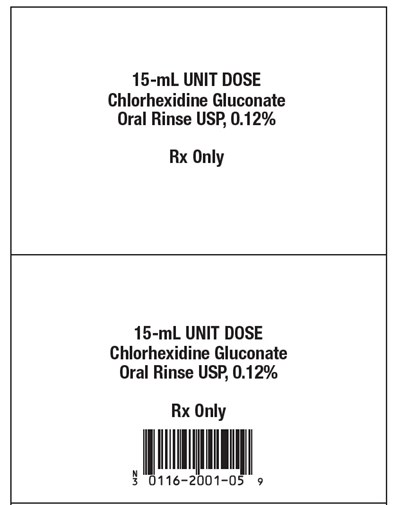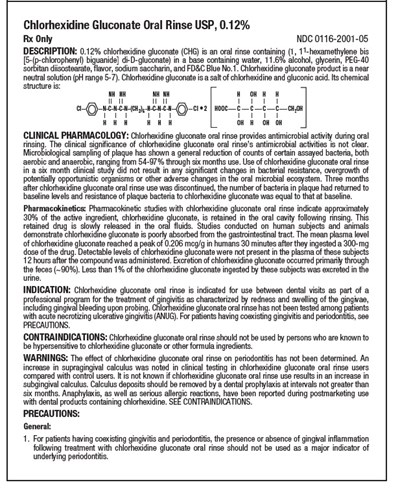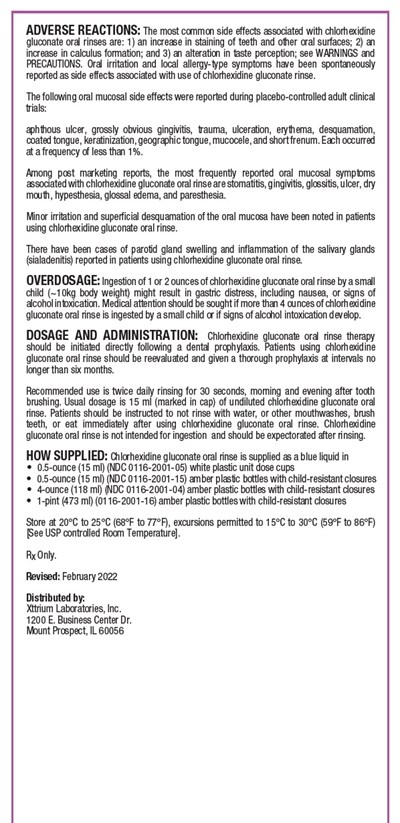Product Images Chlorhexidine Gluconate
View Photos of Packaging, Labels & Appearance
- XT logo.jpg - XT logo
- 1 - digluconate chlorhexidine structure
- 1999CHGUDCINSTA - insta 1
- 1999CHGUDCINSTA - insta 2
- 1999CHGUDCINSTA - insta 3
- 1999CHGUDCINSTA - insta 4
- 1999XTTSPDLIDA - pet 05
- 4-oz 1 - pet04 1
- 4-oz 2 - pet04 2
- 4-oz PDP - pet04 p
- Principal Display Panel - pet15 1
- 15 oz. Bottle Page 2 - pet15 2
- 15 oz. Bottle Page 3 - pet15 3
- 15 oz. Bottle Page 3 - pet15 4
- 15 oz. Bottle Page 4 - pet15 5
- 16-oz 1 - pet16 1
- 16-oz 2 - pet16 2
- 16-oz 3 - pet16 3
- 16-oz PDP - pet16 p
Product Label Images
The following 19 images provide visual information about the product associated with Chlorhexidine Gluconate NDC 67296-1715 by Redpharm Drug, Inc., such as packaging, labeling, and the appearance of the drug itself. This resource could be helpful for medical professionals, pharmacists, and patients seeking to verify medication information and ensure they have the correct product.
XT logo.jpg - XT logo

This text is a product label or identification code for an oral rinse solution containing Chlorhexidine Gluconate 0.12%, identified by the code NOC 0116-2001-16.*
1999CHGUDCINSTA - insta 1

This is a 15 mL unit dose of Chlorhexidine Gluconate oral rinse USP, with a concentration of 0.12%. The product is only available with a prescription (Rx Only). There is a unique identifier code printed on the label, which is 30116-2001-05 9.*
1999CHGUDCINSTA - insta 2

Chlorhexidine Gluconate Oral Rinse USP, 0.12% is an antimicrobial solution used to treat gingivitis, characterized by redness and swelling of the gums, and gingival bleeding. The solution contains 0.2% of Chlorhexidine gluconate, which is poorly absorbed from the gastrointestinal tract and is retained in the oral cavity following rinsing. Studies have shown a general reduction in counts of certain assayed bacteria by using the solution, but the clinical significance of its antimicrobial activities is not clear. An increase in supragingival calculus was noted in clinical testing. The solution should not be used by persons who are known to be hypersensitive to Chlorhexidine gluconate or other formula ingredients.*
1999CHGUDCINSTA - insta 3

Chlorhexidine gluconate oral rinse is a medication that can cause staining of oral surfaces, such as teeth, restorations, and the dorsum of the tongue, in many patients. Clinical testing data has shown that in some cases, staining can be difficult to remove, requiring additional time or even tooth restoration. Some users may also experience a temporary alteration in taste perception, while rare cases of permanent taste alteration have been reported. The drug has not been established as effective or safe for use in children under eight, and patients with anterior facial restorations or rough surfaces should be treated with caution. While evidence of harm to fetuses was not found in animal studies, the use of this drug in pregnant women should be limited to cases where it is clearly needed. Caution should also be exercised when administering this medication to nursing women. Adverse reactions associated with the use of chlorhexidine gluconate oral rinse include staining of the teeth and other oral surfaces, an increase in calculus formation, alteration of taste perception, oral irritation, and local allergy-type symptoms. Patients have reported cases of parotid gland swelling and inflammation of the salivary glands.*
1999CHGUDCINSTA - insta 4

Chlorhexidine gluconate oral rinse is a treatment for gingivitis that should be used twice daily for 30 seconds after brushing teeth. The recommended dosage is 15 ml of undiluted rinse, and patients should not ingest or swallow the product. The rinse should not be used in individuals with a sensitivity to it or its components. It may cause tooth discoloration and an increase in tartar formation. To minimize discoloration, daily brushing and flossing is necessary, and regular dental visits are important for stain and tartar removal. The rinse can cause a bitter taste, and patients must not rinse with water or other mouthwashes immediately after using it. Any adverse effects should be promptly reported to a healthcare provider. In case of ingestion, medical attention is required, and the product should be stored at a controlled room temperature away from children.*
4-oz PDP - pet04 p

Vlift is an oral rinse solution consisting of chlorhexidine gluconate 0.12%, water, and 11.6% alcohol. It comes in a 4oz (118 ml) container with an NDC code of 0116-2001-04. To use, swish 1 tablespoon of undiluted solution in the mouth for 30 seconds twice a day, after breakfast and before bedtime, or as prescribed. It is important to not mix the solution with water immediately after use to minimize the medicinal taste. The solution should be kept out of reach of children.*
Principal Display Panel - pet15 1

This is a description of an oral rinse medication with the NDC code 0116-2001-15. The medication contains 0.12% Chlorhexidine Gluconate, and it is an alcohol-based solution. The directions for use involve swishing the undiluted medication in the mouth for 30 seconds and then spitting it out. The medication should not be rinsed with water immediately after use to minimize the medicinal taste. The medication comes in a 0.5 fl oz (15 mL) bottle and is for Rx only. The ingredients of the medication include water, glycerin, PEG-40 sorbitan, sodium saccharin, and FD&.*
15 oz. Bottle Page 2 - pet15 2

Chlorhexidine Gluconate 0.12% Oral Rinse, USP is an oral rinse that contains chiorhexidine gluconate and is used as part of a professional program for the treatment of gums characterized by redness and swelling of the gingivae, including gingival bleeding upon probing. Chlorhexidine Gluconate provides an antimicrobial activity during oral rinsing, and its clinical significance is not clear. Chemical structure of Chlorhexidine Gluconate is also given. It is not recommended for persons who are known to be hypersensitive to chlorhexidine gluconate or other formula ingredients, and a dental prophylaxis should be done to remove calculus deposits at intervals not greater than six months. Anaphylaxis, as well as serious allergic reactions, have been reported during postmarketing use with dental products containing chlorhexidine.*
15 oz. Bottle Page 3 - pet15 3

This text provides information on precautions for the use of Chlorhexidine Gluconate Oral Rinse. It warns that gingival inflammation may not be a reliable indicator of underlying periodontitis, and the rinse may cause staining of oral surfaces such as teeth and restorations. Patients with anterior facial restorations may need to be excluded from treatment if permanent discoloration is not acceptable. Taste perception may be altered during treatment, and caution is advised for pregnant and nursing patients as the drug may be excreted in human milk. Pediatric effectiveness and safety have not been established. Carcinogenic and mutagenic effects were not observed in studies in rats and mice.*
15 oz. Bottle Page 3 - pet15 4

This text contains information about chlorhexidine gluconate oral rinse, an antiseptic mouthwash. It provides dosing instructions, possible adverse reactions and side effects, as well as warnings regarding overdosing and ingestion. It also indicates the manufacturer and how it is supplied.*
15 oz. Bottle Page 4 - pet15 5

This text provides information on how to use Chlorhexidine Gluconate Oral Rinse to treat gingivitis and control gum bleeding. It includes instructions on how to use the rinse, precautions to take to avoid side effects, side effects that may occur, and also mentions the ingredients and how to store the product. If used as directed, it can help reduce redness and swelling of the gums but may cause tooth discoloration or increase in calculus formation, which is why it is important to see a dentist regularly.*
16-oz 1 - pet16 1

Chlorhexidine gluconate oral rinse is an antimicrobial solution used to treat gingivitis characterized by redness and swelling of the gingiva, including gingival bleeding upon probing. It reduces counts of certain bacteria for up to six months of use. It is retained in the oral cavity following use and is slowly released into the oral fluids. It is poorly absorbed from the gastrointestinal tract and mainly excreted through the feces. The use of this rinse can cause staining of oral surfaces such as teeth and restorations, which can be removed by conventional professional prophylactic techniques. It is not established whether it is effective and safe for children under 18. No impaired fertility or teratogenic effects were observed in animal studies, but well-controlled studies in pregnant women have not been done. Caution should be exercised when administered to nursing women.*
16-oz 2 - pet16 2

The text describes the adverse reactions and oral mucosal side effects associated with the use of chlorhexidine gluconate oral rinse. The side effects include an increase in staining of teeth and oral surfaces, an increase in calculus formation, alteration in taste perception, and oral irritation. Other reported side effects are aphthous ulcers, gingivitis, trauma, ulceration, erythema, coated tongue, and shortfrenum among others. The dosage and administration of the oral rinse are provided along with instructions for use. The oral rinse should not be ingested and medical attention should be sought if ingestion occurs or signs of alcohol intoxication develop. The text also provides information on how the oral rinse is supplied and how it should be stored.*
16-oz PDP - pet16 p

This text describes a product called Chlorhexidine Gluconate Oral Rinse USP, with a certain percentage of chlorhexidine gluconate in a base containing water, alcohol, glycerin, PEG-40 sorbitan diisostearate, flavor, sodium saccharin and FD&G Blue No.1. It also presents instructions on how to open and reseal the product. The text also mentions the chemical structure of chlorhexidine gluconate.*
* The product label images have been analyzed using a combination of traditional computing and machine learning techniques. It should be noted that the descriptions provided may not be entirely accurate as they are experimental in nature. Use the information in this page at your own discretion and risk.




